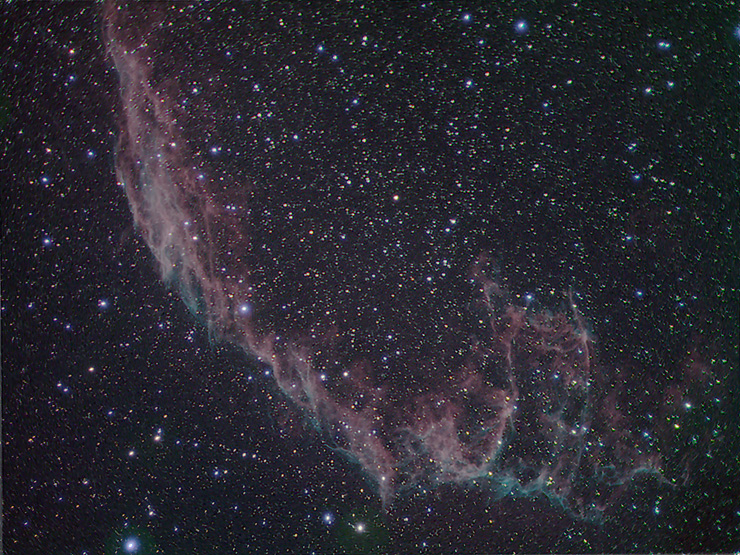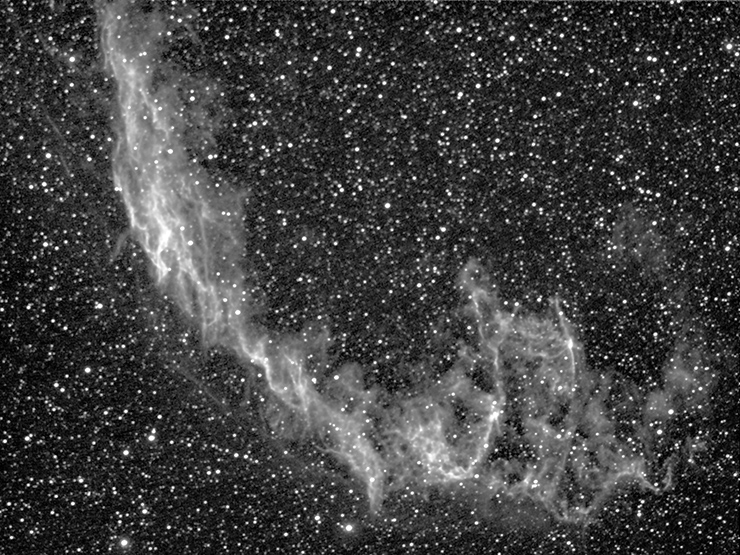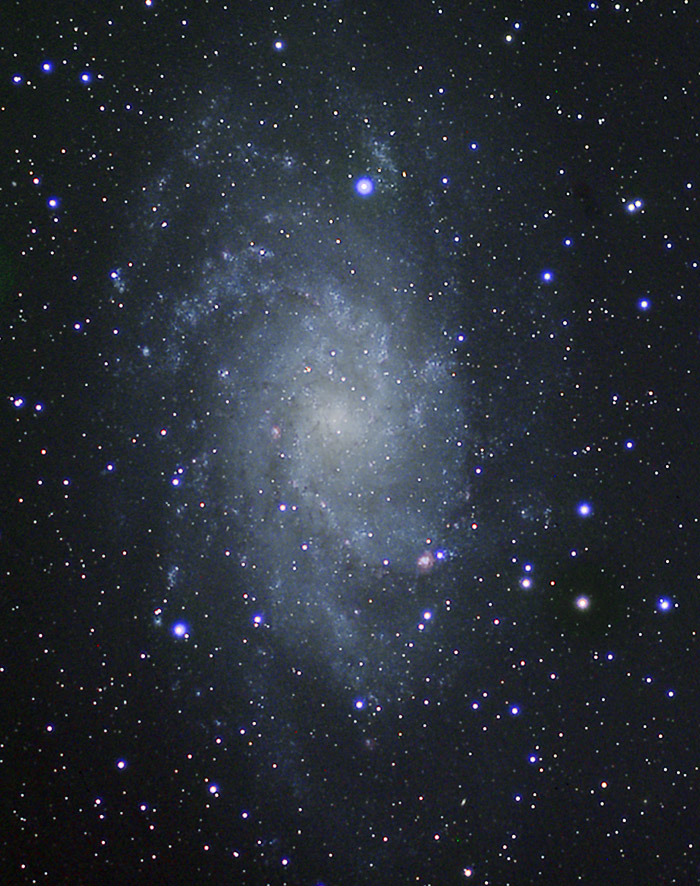The Starry Night, 27 :: home :: |
|
11/7/2010: I pulled the kinks out of the astrophotography setup I put together back at the first of October. Tonight I finally set the 5-inch up again for deep-sky photos. I had no special plans for the evening except getting re-acquainted with hard- and software. I spent a substantial portion of my available window (that is, between getting everything working again and the Veil Nebula dropping into the trees) working on compositon. The large, intricate arc of the Veil just fits the ST2000XM frame provided the camera is rotated and positioned just so. In the end, I settled for six, 5-minute exposures, two each in R, G, and B. I aim to pick up this subject at twilight tomorrow, then follow it from the zenith into the woods. That ought to be time enough to get it right. In the meantime, here's a quick look at signal-starved data:
Astro-Physics 5-inch F6 @ F4.3.
Not bad for half an hour's exposure, not so impressive for four hours at the telescope. Got to get back into practice soon. Which puts me in mind of ... something. What is that nagging, inspiring, intimidating quote making the rounds? You mean this one? "In fact, researchers have settled on
what they believe is a magic number for true expertise: 10,000 hours." Yeah, that's the one. 11/8/2010. Someone on AstroMart is selling an A-P 400QMD mount for $1295. That is the proverbial steal. I had better take advantage of what my Mach1 can do that a 400QMD cannot lest I come to believe that I have wasted the proverbial, uhm, wheelbarrow load of cash. So I went outside with a spirit level, manually set the mount to the Park 1 position, clamped the axes, initialized the hand controller, and told the mount to slew the telescope to Venus. The aim looks plausible, but with the cameras in place rather than an eyepiece, I can't know for sure how well the alignment worked. Assuming the alignment is reasonable, then when it gets dark, I'll simply command a slew to NGC 6992 (aka, the larger arc of the Veil), and resume last night's project.
NGC 6992, part of the Veil Nebula
And so it happened! In deep twilight, I slewed to M13, centered and recalibrated, then Deneb, and then I asked for a slew to NGC 6992. Bingo. I took two hours of hydrogen-alpha data using 15 minute subs. G, B, and R data followed via five minute subrames. G and B came in routinely; R is courting the treetops. I haven't configured the netbook controlling the camera and guiding the mount for full remote operation, so I have to go outside and change filters, start runs, etc., but it does save images to a shared directory on its C: drive. That means I can watch as images appear there and check them out immediately. Whether there'll be time for all six of the red channel subframes is the mystery of the moment, but I think I can either press the H-a data to fill in in the event some red channel data goes missing or weight the red channel appropriately. The first red frame is clear of the trees; the second frame looks good, too; three is good. I can't quite shake the impression that R needs to be refocused some, despite the fact that the filters are supposed to be parfocal. I'm not going to worry too much about that tonight since the RGB data is intended merely to provide color information for the H-a images which will serve as the luminance channel. Four may be showing some interference (a lighter region that might be trees reflecting dim, ambient light). Five is definitely in the trees, and the DSI appears to have lost sight of the guide star. After collecting the color data, I shot two dark frames, one of 15 minutes duration, one of 5 minutes. I've presented the image above slightly
lighter than is my wont in order to insure the easy visibility of the
intricate shock
fronts within the arc. There's a little field rotation and focus could
be better. So this remains a ways from the best this kit can produce.
Here's a look at the hydrogen-alpha signal alone, two hours worth:
This (too-aggressively stretched) rendition of the h-a data makes me think it would be worth shooting more of the same tonight. Look at the upper left, just ahead of the expanding loop. See those faint, straight lines? Presumably compression in the interstellar medium ahead of the expanding material from the supernova. There's a similar, larger, longer linear feature at bottom left which looks -- in the full resolution image and with some imagination -- like a tilted sheet viewed on edge. At lower right, the supernova shell seems to be impinging on denser material, probably a molecular cloud of some sort. The light on that impact front is not predominantly hydrogen-alpha (see the color image above). All in all, another few hours of exposure would likely be rewarded. How about better polar alignment, careful focusing, and some 30 minute subs? Start with more red data to fill in yesterday's gap and refine composition in the process.
While taking the first, short dark last night, I asked for a slew to M33 and the Mach1 put it on the SBIG's chip, no problem. I centered the galaxy, recalibrated, checked focus in the L channel, and selected a guide star. As soon as the long dark is done, I'll take minimal color data and let the telescope gather luminance data on its own for the rest of the night. I'm going to keep the exposures short to keep field stars from burning out or expanding too far beyond the color data. I'll cover the netbook with the telescope's cover and put a light bulb under there too keep everything warm through the night.
On inspection, the last 15 frames were in the trees; images to that point look fine. I discarded the first two luminance frames for guiding errors (my fault -- I was covering the computer and shook the telescope in the process). So that's 10 minutes in each color channel and 165 minutes in luminance. The blue channel is bloated more than I expected, possibly owing to the extreme stretch required of the thin color data. |
:: top ::
© 2010, David Cortner



